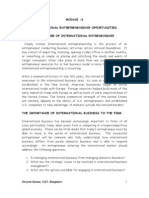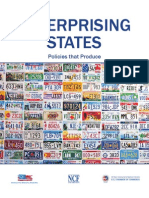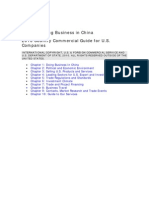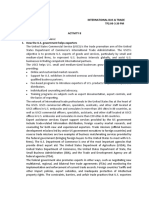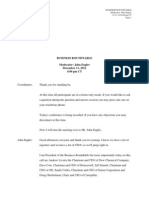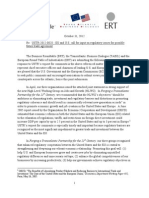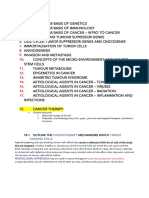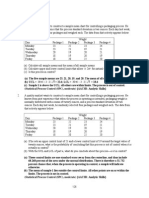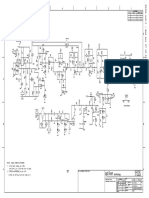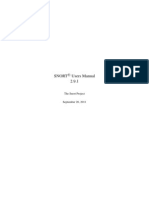Taking Action For America: Open Markets For International Trade and Investment
Taking Action For America: Open Markets For International Trade and Investment
Uploaded by
Business RoundtableCopyright:
Available Formats
Taking Action For America: Open Markets For International Trade and Investment
Taking Action For America: Open Markets For International Trade and Investment
Uploaded by
Business RoundtableOriginal Title
Copyright
Available Formats
Share this document
Did you find this document useful?
Is this content inappropriate?
Copyright:
Available Formats
Taking Action For America: Open Markets For International Trade and Investment
Taking Action For America: Open Markets For International Trade and Investment
Uploaded by
Business RoundtableCopyright:
Available Formats
OPEN MARKETS FOR INTERNATIONAL TRADE AND INVESTMENT
Fast Facts
In 2008, more than 38 million jobs in America more than one in five depended on international trade exports and imports.1 In 1992, a year before the implementation of a series of U.S. bilateral, regional and multilateral trade agreements, the total of trade-related jobs in the United States was only 14.5 million.2 The growth of 24 million new trade-related jobs for U.S. workers in two decades demonstrates clearly that trade is an important engine for economic growth and job creation. In 2009, more than 275,000 U.S. companies exported merchandise to customers abroad, and nearly 180,000 U.S. companies imported raw materials, components and finished products for U.S. manufacturers, services providers and consumers.3 Exports also support higher-paying jobs. Positions in the manufacturing sector linked to the export of goods pay on average 18 percent more than other jobs.4 Trade agreements are essential to creating economic and strategic benefits for the United States. The Uruguay Round of multilateral trade negotiations, which resulted in the creation of the World Trade Organization (WTO), was projected to add at least $70 billion to global economic output. More than a quarter of this gain $19.8 billion was estimated to accrue to the United States.5
U.S. exports represent a significant share of U.S. GDP and have increased over time, showing the importance of exports to U.S. economic growth and job creation.
Exports Share of GDP
14% 12% 10% 8% 6% 4%
1980
1985
1990
1995
2000
2005
2010
Source: U.S. Department of Commerce, Bureau of Economic Analysis
Existing U.S. trade agreements represent a large share of U.S. exports, and there is room for more agreements.
Shares of U.S. Exports
100% 80% 60% 40%
20% 0%
2001
2003
2005
2007
2009
2011
Rest of World U.S. FTAs
Source: Bureau of Economic Affairs, Foreign Trade Division, Exports to Foreign Countries, U.S. State Department
About 40 percent of U.S. exports now go to the nations Free Trade Agreement (FTA) partners, and U.S. exports to FTA partner countries are growing faster than U.S. exports to countries that do not have FTAs with the United States. In 2011, the United States had a roughly $50 billion manufactured goods trade surplus with its 17 FTA partner countries combined.6
22 Business Roundtable
The U.S. FTAs in effect in 2008 (before the global recession) generated $305 billion in U.S. output (2.1 percent of GDP), expanded U.S. exports of goods and services by $463 billion, and supported 5.4 million U.S. jobs.7 The recently approved FTAs with South Korea, Colombia and Panama are expected to increase U.S. exports by more than $10 billion and reinforce important national security and foreign policy relationships.8 Investment in the United States is also essential to economic growth and job creation. U.S. affiliates of foreign companies employed 5.3 million Americans in 2009 4.7 percent of private-sector employment.9 In 2007, more than 63 million10 Americans worked for U.S. multinational companies either directly or through their supply chains and U.S. multinational companies have accounted for nearly one-third of the growth of real private-sector GDP since 1990.11 With more than 95 percent of the worlds population12 representing 80 percent of the worlds purchasing power13 outside the United States, U.S. economic growth and job creation depend on expanding U.S. trade and investment opportunities, so U.S. companies can sell more American products and services to these customers.
Vibrant and open markets for international trade and investment are a necessary prerequisite for generating new economic growth and job creation opportunities for U.S. businesses and workers. Increased use of bilateral and regional trade and investment agreements with like-minded countries and a strong system of multilateral agreements and rules under the WTO create these opportunities by eliminating trade and investment barriers and preventing discriminatory treatment of foreign goods, services and investment. In contrast, measures that close off markets from competition or are discriminatory quickly dampen international commerce and undermine economic growth and job creation. International trade and investment agreements are also essential to ensuring fair and competitive business practices across countries. They provide the rules under which the United States and its businesses and workers can enforce their rights to open markets and prevent discriminatory treatment. The United States initially led the way in using bilateral and regional trade agreements to expand trade quickly by opening markets more deeply and setting strong rules for international commerce. Given that 95 percent of the worlds population lives outside the United States and the rapid rise of the middle class in China, India, Brazil and other emerging markets, the United States needs to lead the way again. Today, all our major trading partners have aggressive bilateral and regional negotiating strategies to compete more effectively for these customers and grow their own economies. For instance, according to the WTO, 297 bilateral and regional trade agreements are currently in force internationally, with another 192 announced or under negotiation.
23 Taking Action for America: A CEO Plan for Jobs and Economic Growth
Until this year, the United States had only 11 regional and bilateral trade agreements in force. The recent passage of trade agreements with South Korea, Colombia and Panama and the ongoing Trans-Pacific Partnership negotiations will help U.S. companies and workers keep pace with their foreign competitors in opening markets for U.S. businesses and workers. However, they are not enough to help U.S. businesses and workers be competitive in world markets and to ensure that high U.S. standards for trade are adopted globally. For U.S. companies and workers to grow their exports, maintain and create jobs, and improve their international competitiveness, the United States needs an active trade and investment policy designed to open foreign markets and keep them open. For many U.S. exporters both small and medium enterprises and larger companies and their workers, U.S. export credit financing from the U.S. Export-Import Bank is a critical piece of such a policy. The U.S. Export-Import Bank enables them to sell their goods and services to foreign customers in todays highly competitive international marketplace, where many foreign competitors enjoy strong export credit support from their own countries. For example, in FY2011, the bank facilitated roughly $41 billion in U.S. export sales by more than 3,600 U.S. companies, supporting nearly 290,000 U.S. jobs.14 To succeed, a robust strategic trade policy requires U.S. domestic policies that will build a highly skilled workforce, strengthen Americas leadership in research and development, enforce and protect U.S. intellectual property rights around the world, and institute globally competitive corporate tax policies. In addition to leveling the playing field for U.S. companies and workers competing abroad, improved access to foreign markets will spur domestic output and the creation of high-paying jobs in America. These benefits do not merely flow to large multinational companies. Indeed,
Open markets are essential for U.S. economic growth and job creation, and international trade and investment agreements are critical tools to open markets and keep them open.
as U.S.-based multinationals expand, they source more inputs from small businesses Douglas R. Oberhelman, and the local communities that depend on them.15
Chairman and CEO, Caterpillar Inc., and Chair, Business Roundtable Competition breeds innovation, and one of Americas greatest comparative advantages International Engagement is its ability to generate new ideas, products and services. Supporting the nations Committee entrepreneurs, global companies, local businesses and their workers will require a
strong and proactive commitment from political leaders to pursuing a forward-looking and sustained trade and investment agenda.
Solutions
Develop and implement active international trade and investment initiatives to help U.S. companies and workers increase their competitiveness in international markets and ensure that U.S. and foreign markets remain open for investment: Provide the President with new and updated international trade and investment negotiating authority; Aggressively pursue strategic bilateral and regional initiatives like the ongoing Trans-Pacific Partnership and a proposed Trans-Atlantic Partnership; Revitalize multilateral and plurilateral negotiations at the WTO;
24 Business Roundtable
Vigorously enforce U.S. rights to open markets and nondiscriminatory treatment under existing and future international agreements; and Grant permanent normal trade relations status to Russia.
Constructively engage China and other emerging growth countries: Target the elimination of market access barriers and discriminatory treatment of exporters and investors through more dynamic bilateral, regional and multilateral initiatives, including investment treaty negotiations; Enforce U.S. rights under international trade and investment rules to ensure that U.S. companies and workers are not disadvantaged by discriminatory foreign policies such as indigenous innovation and other local preference requirements and that other countries comply with those rules; and Enhance multilateral efforts to address currency issues, and resist counterproductive unilateral currencyrelated sanctions.
Reauthorize the U.S. Export-Import Bank on a long-term basis before its current short-term extension expires, with a sufficient increase in its lending cap, so it can continue to help U.S. exporters compete for sales abroad and support the U.S. jobs that depend on those sales. Eliminate U.S. regulatory impediments to exports, including through export control reforms. Modernize and reform U.S. domestic policies along the lines proposed by this Taking Action for America report to help U.S. companies and workers better compete globally to expand the U.S. economy and support jobs in America.
1 2
Baughman, L., & Francois, J. (2010). Trade and American jobs: The impact of trade on U.S. and state-level employment: An update. Washington, DC: Business Roundtable. Retrieved from http://businessroundtable.org/studies-and-reports/trade-and-american-jobs Baughman, L., & Francois, J. (2007). Trade and American jobs: The impact of trade on U.S. and state-level employment: An update. Washington, DC: Business Roundtable. Retrieved from http://businessroundtable.org/studies-and-reports/trade-and-american-jobs-the-impact-of-trade-onu.s.-and-state-level-employm/ U.S. Census Bureau. (2011). A profile of U.S. importing and exporting companies, 20082009. Washington, DC. Retrieved from www.census.gov/ foreign-trade/Press-Release/edb/2009/ Riker, D. (2010). Do jobs in export industries still pay more? And why? Manufacturing and services economics brief. Washington, DC: U.S. International Trade Administration, Office of Competition and Economic Analysis. Retrieved from http://goo.gl/UpHaq Brown, D., Deardorff, A., & Stern, R. (2002). Computational analysis of multilateral trade liberalization in the Uruguay round and Doha development round. Ann Arbor, MI: University of Michigan. Retrieved from http://goo.gl/pPiBj Calculated based on tariff and trade data from the U.S. Department of Commerce and the U.S. International Trade Commission. Retrieved from the U.S. International Trade Commission Dataweb on February 10, 2012. Baughman, L., & Francois, J. (2010). Opening markets, creating jobs: Estimated U.S. employment effects of trade with FTA partners. Washington, DC: U.S. Chamber of Commerce. Retrieved from www.uschamber.com/reports/opening-markets-creating-jobs-estimated-us-employment-effectstrade-fta-partners U.S. International Trade Commission. (2007). U.S.-Korea Free Trade Agreement: Potential economy-wide and selected sectoral effects. Washington, DC. Retrieved from http://goo.gl/ycDhP; and U.S. International Trade Commission. (2006). U.S.-Colombia Trade Promotion Agreement: Potential economy-wide and selected sectoral effects. Washington, DC. Retrieved from http://goo.gl/CkRTI
3 4 5 6 7
25 Taking Action for America: A CEO Plan for Jobs and Economic Growth
Anderson, T. (2011). U.S. affiliates of foreign companies: Operations in 2009. Washington, DC: U.S. Department of Commerce, Bureau of Economic Analysis. Retrieved from http://goo.gl/98noK
10 Business Roundtable. (2011). Taxation of American companies in the global marketplace: A primer. Washington, DC. Retrieved from http:// businessroundtable.org/studies-and-reports/taxation-of-american-companies-in-the-global-marketplace-a-primer/ 11 McKinsey Global Institute. (2010). Growth and competitiveness in the United States: The role of its multinational companies. Washington, DC. Retrieved from www.mckinsey.com/Insights/MGI/Research/Productivity_Competitiveness_and_Growth/Growth_and_competitiveness_in_US 12 United Nations, Department of Economic and Social Affairs. (2011). World population prospects: The 2010 revision. New York, NY. Retrieved from http://esa.un.org/unpd/wpp/ 13 International Monetary Fund. (2012). World economic outlook database. Washington, DC. Retrieved from www.imf.org/external/pubs/ft/ weo/2011/02/weodata/index.aspx 14 Export-Import Bank of the United States. (2011). 2011 annual report. Washington, DC. Retrieved from www.exim.gov/about/reports/ar/2011/ index.html 15 Slaughter, M. (2010). Mutual benefits, shared growth: Small and large companies working together. Washington, DC: Business Roundtable. Retrieved from http://businessroundtable.org/studies-and-reports/mutual-benefits-shared-growth-small-and-large-companies-working-togeth/
26 Business Roundtable
You might also like
- Trade Handbook 2013Document83 pagesTrade Handbook 2013Business Roundtable100% (1)
- Sicilian O'Kelly VariationDocument21 pagesSicilian O'Kelly VariationJuan Andres Auernheimer100% (2)
- Cooper Nova Manual S280421 Part1Document14 pagesCooper Nova Manual S280421 Part1Arliel John GarboNo ratings yet
- 02046-Tpa Paper Feb02Document21 pages02046-Tpa Paper Feb02losangelesNo ratings yet
- International Trade and Investment: Trade Liberalization: A Key Contributor To The Strength of The U.S. EconomyDocument22 pagesInternational Trade and Investment: Trade Liberalization: A Key Contributor To The Strength of The U.S. EconomylosangelesNo ratings yet
- HW - International TradeDocument5 pagesHW - International TraderoalipioNo ratings yet
- Committee JurisdictionDocument4 pagesCommittee Jurisdictionapi-335853566No ratings yet
- Competing in World MarketsDocument28 pagesCompeting in World Marketsmonel_24671No ratings yet
- International Trade Term Paper TopicsDocument4 pagesInternational Trade Term Paper Topicsdoawpfcnd100% (1)
- International Trade and FinanceDocument54 pagesInternational Trade and Financenurallyssa harahapNo ratings yet
- International Marketing CH1Document7 pagesInternational Marketing CH1Nour Ali100% (1)
- Competing in Global Markets: Lecturer: S M Shahidul Alam Date: 01/08/2018Document26 pagesCompeting in Global Markets: Lecturer: S M Shahidul Alam Date: 01/08/2018mahfuzNo ratings yet
- Agriculture Law: RL33945Document22 pagesAgriculture Law: RL33945AgricultureCaseLawNo ratings yet
- 2010 Trade Protectionism - Reasons and OutcomesDocument13 pages2010 Trade Protectionism - Reasons and OutcomesRihen Tagazi100% (3)
- ImportDocument3 pagesImportKevin DrarNo ratings yet
- US China TradearDocument7 pagesUS China TradearnadiaNo ratings yet
- 02 - Dmba402 - International Business ManagementDocument7 pages02 - Dmba402 - International Business ManagementHari KNo ratings yet
- Business in A Global EnvironmentDocument17 pagesBusiness in A Global Environmentria fajrianiNo ratings yet
- Economic IntegrationDocument16 pagesEconomic IntegrationVu MyNo ratings yet
- International Business and Trade3Document41 pagesInternational Business and Trade3rovicabarado99No ratings yet
- Country Commercial Guide ChinaDocument158 pagesCountry Commercial Guide Chinasakshi85No ratings yet
- BIT Aff Updates - Michigan7 2016Document38 pagesBIT Aff Updates - Michigan7 2016ibdeadotwitchNo ratings yet
- Competing in World MarketsDocument26 pagesCompeting in World MarketsMuhammad Arslan QadirNo ratings yet
- Cea Trade Report Final Non-Embargoed v2Document52 pagesCea Trade Report Final Non-Embargoed v2hervegaelmutebaNo ratings yet
- What Is International BusinessDocument4 pagesWhat Is International BusinessRavimohan RajmohanNo ratings yet
- International Economic NotesDocument57 pagesInternational Economic NotesAamale KhanNo ratings yet
- Assignment 3Document11 pagesAssignment 3Vansh DuaNo ratings yet
- CCCCC CCCC CC CCC CCC CCCCCCC CCC C C CC CCCCC C C!Document18 pagesCCCCC CCCC CC CCC CCC CCCCCCC CCC C C CC CCCCC C C!Kasang KapsmaNo ratings yet
- Negotiating TTIP FinalDocument164 pagesNegotiating TTIP FinalBlahNo ratings yet
- World Trade OrganizationDocument78 pagesWorld Trade OrganizationadityaNo ratings yet
- What Is Foreign TradeDocument2 pagesWhat Is Foreign Tradeviswaprakash_vNo ratings yet
- Module - 6 International Entrepreneurship Opportunities The Nature of International EntreneurshipDocument12 pagesModule - 6 International Entrepreneurship Opportunities The Nature of International EntreneurshipSourabha K DarshanNo ratings yet
- Free Trade ArgumentsDocument3 pagesFree Trade ArgumentsNargis AmieNo ratings yet
- NextDocument38 pagesNextSruthy MenonNo ratings yet
- ECOMACDocument3 pagesECOMACquennieguanco22No ratings yet
- India H ResDocument4 pagesIndia H ResDan CampbellNo ratings yet
- Continue Progress On A Key Trade RelationshipDocument3 pagesContinue Progress On A Key Trade RelationshipBrookings InstitutionNo ratings yet
- Economics Stimulus EssayDocument4 pagesEconomics Stimulus Essaytimberap 27No ratings yet
- Global Trade RegimeDocument6 pagesGlobal Trade RegimeMikaella FernandoNo ratings yet
- Tugas EconDocument8 pagesTugas EconJeremy HooNo ratings yet
- Basic MacroDocument7 pagesBasic MacroAlexis JaneNo ratings yet
- Group-9-Narrative-Report (1)Document9 pagesGroup-9-Narrative-Report (1)jhasmintutaanNo ratings yet
- MB0037 FALL 2010 SolutionsDocument41 pagesMB0037 FALL 2010 Solutionshumayun25666No ratings yet
- UNIT-2: Overview of India & World Trade - EXIM PolicyDocument16 pagesUNIT-2: Overview of India & World Trade - EXIM PolicyNandhu SanthoshNo ratings yet
- International Economics FinalDocument83 pagesInternational Economics FinalMikylla Rodriguez VequisoNo ratings yet
- Enterprising States 2012 WebDocument90 pagesEnterprising States 2012 WebDavid LombardoNo ratings yet
- U.S. Trade PolicyDocument11 pagesU.S. Trade PolicyRohan RoyNo ratings yet
- Doing Business in ChinaDocument158 pagesDoing Business in ChinaMichael Grenon100% (1)
- International Business, 7EDocument22 pagesInternational Business, 7ERodric MarbaniangNo ratings yet
- IBM - Complete Question BankDocument18 pagesIBM - Complete Question BankMohd AmanNo ratings yet
- International BusinessDocument27 pagesInternational BusinessRizsNo ratings yet
- Act 8 International Bus and TradeDocument8 pagesAct 8 International Bus and Tradejulie ann mayoNo ratings yet
- TERMppr US Trade PolicyDocument33 pagesTERMppr US Trade Policysampada13No ratings yet
- Free Trade Term PaperDocument5 pagesFree Trade Term Paperc5jxjm5m100% (1)
- Globalization of Economic RelationsDocument20 pagesGlobalization of Economic RelationsKristine OrtizNo ratings yet
- The Pros and Cons of Globalization: Start Download - View PDFDocument5 pagesThe Pros and Cons of Globalization: Start Download - View PDFClaudiu RaicaNo ratings yet
- ImportanceDocument8 pagesImportanceHaseeb AbbasiNo ratings yet
- International TradeDocument10 pagesInternational TradeApex LegendsNo ratings yet
- Master of Business Administration - MBA Semester 4 MB0037 - International Business Management Assignment Set-1Document36 pagesMaster of Business Administration - MBA Semester 4 MB0037 - International Business Management Assignment Set-1Araj99No ratings yet
- Export to Explode Cash Flow and Profits: Creating New Streams of Business in Asia, Africa and the Americas with Little InvestmentFrom EverandExport to Explode Cash Flow and Profits: Creating New Streams of Business in Asia, Africa and the Americas with Little InvestmentNo ratings yet
- Implementation of The Affordable Care ActDocument103 pagesImplementation of The Affordable Care ActBusiness RoundtableNo ratings yet
- Business Roundtable Major Regulations of ConcernDocument19 pagesBusiness Roundtable Major Regulations of ConcernBusiness RoundtableNo ratings yet
- Conflict Minerals BriefDocument198 pagesConflict Minerals BriefBusiness RoundtableNo ratings yet
- Transcript: Q4 2012 Business Roundtable CEO Economic Outlook Survey CallDocument19 pagesTranscript: Q4 2012 Business Roundtable CEO Economic Outlook Survey CallBusiness RoundtableNo ratings yet
- Call Transcript To Announce The BRT CEOs Letter On The Need To Avoid The Fiscal CliffDocument25 pagesCall Transcript To Announce The BRT CEOs Letter On The Need To Avoid The Fiscal CliffBusiness RoundtableNo ratings yet
- The Bottom Line 11 13 12 PNTRDocument1 pageThe Bottom Line 11 13 12 PNTRBusiness RoundtableNo ratings yet
- National Survey May 26-27, 2012 1000 Registered Voters Margin of Error +/-3.1Document6 pagesNational Survey May 26-27, 2012 1000 Registered Voters Margin of Error +/-3.1Business RoundtableNo ratings yet
- TABD-BRT-ERT Public Comments On US/EU Regulatory Cooperation IssuesDocument12 pagesTABD-BRT-ERT Public Comments On US/EU Regulatory Cooperation IssuesBusiness RoundtableNo ratings yet
- Response: Consultative Document On Margin Requirements For Non-Centrally-Cleared DerivativesDocument15 pagesResponse: Consultative Document On Margin Requirements For Non-Centrally-Cleared DerivativesBusiness RoundtableNo ratings yet
- Transcript: Q3 2012 Business Roundtable CEO Economic Outlook Survey CallDocument18 pagesTranscript: Q3 2012 Business Roundtable CEO Economic Outlook Survey CallBusiness RoundtableNo ratings yet
- Mission Critical: A Public-Private Strategy For Effective CybersecurityDocument28 pagesMission Critical: A Public-Private Strategy For Effective CybersecurityBusiness RoundtableNo ratings yet
- Installation Manual Sartorius Load Cell Type PR6201Document157 pagesInstallation Manual Sartorius Load Cell Type PR6201Denny19900% (1)
- CAS Student HandbookDocument11 pagesCAS Student HandbookBurak ȘenNo ratings yet
- 18.1 Outline The Mechanisms Which: Chemotherapy Target Dividing CellsDocument8 pages18.1 Outline The Mechanisms Which: Chemotherapy Target Dividing CellsSenthereng MoaisiNo ratings yet
- Quality ManagementDocument10 pagesQuality ManagementTifarie Luesas50% (4)
- Gallien-Krueger 400rb-Iv SCHDocument30 pagesGallien-Krueger 400rb-Iv SCHDewa Studio100% (2)
- NCR SelfServ 21 Product Datasheet BrandedDocument2 pagesNCR SelfServ 21 Product Datasheet BrandedNiraj ShakyaNo ratings yet
- 2D Dr. Jigs Danila-Luzon MHO SummitDocument16 pages2D Dr. Jigs Danila-Luzon MHO SummitKristel Joy Verzon-BunaganNo ratings yet
- Dear Students: L4: Microstructure of Salivary Glands and TongueDocument8 pagesDear Students: L4: Microstructure of Salivary Glands and TongueBoody KhalilNo ratings yet
- Ss7 Pocket GuideDocument24 pagesSs7 Pocket Guideshwetank_vNo ratings yet
- Human Resources and Human Resources ManagementDocument7 pagesHuman Resources and Human Resources ManagementSonny Boy SajoniaNo ratings yet
- Nand 01 GW 3 B 2 N 6Document64 pagesNand 01 GW 3 B 2 N 6marquitos550bNo ratings yet
- Keisha Garcia - Homework #2Document2 pagesKeisha Garcia - Homework #2hoseokfilmsNo ratings yet
- vccm600 Installation Manual PDFDocument4 pagesvccm600 Installation Manual PDFtalaindioNo ratings yet
- MODULE 4 5 Nav Watch 2Document8 pagesMODULE 4 5 Nav Watch 2Faith MagluyanNo ratings yet
- JSA-005 General Lifting Activity by Crane or Boom-TruckDocument5 pagesJSA-005 General Lifting Activity by Crane or Boom-Truckqadeer55afridiNo ratings yet
- Lecture #19: Moments of InertiaDocument19 pagesLecture #19: Moments of InertiaAfiqah ZainuddinNo ratings yet
- Sedimen UrinDocument73 pagesSedimen UrinHerbanu PramonoNo ratings yet
- T40 (Key)Document7 pagesT40 (Key)tun100% (1)
- Allengers 325 RF Installation and Service Manual Relay Series and Parallel CircuitsDocument34 pagesAllengers 325 RF Installation and Service Manual Relay Series and Parallel CircuitsM . BabjiNo ratings yet
- MSDS - Reagent ModuleDocument8 pagesMSDS - Reagent ModuleEdwin AgustianNo ratings yet
- Snort ManualDocument220 pagesSnort Manualfububoy87No ratings yet
- Demantra TablesDocument6 pagesDemantra Tablesjawahar joshuaNo ratings yet
- Madeviral - Social Media Management ServicesDocument12 pagesMadeviral - Social Media Management ServicesBombom WillkinsonNo ratings yet
- Singnal and SystemDocument67 pagesSingnal and Systemjohn cenaNo ratings yet
- Chaume 2013Document20 pagesChaume 2013Angela MejíasNo ratings yet
- Vw-Audi Oil Spec ArticleDocument5 pagesVw-Audi Oil Spec ArticleLindsay MooreNo ratings yet
- Michels Canada Completes Canada's Longest HDD Installation - World PipelinesDocument3 pagesMichels Canada Completes Canada's Longest HDD Installation - World PipelinesNutthakarn WisatsiriNo ratings yet
- 1 Corinthians SampleDocument79 pages1 Corinthians SampleGelci Andre Colli50% (2)































